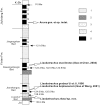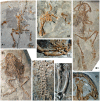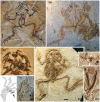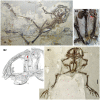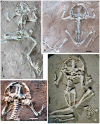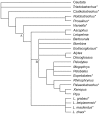Anurans from the Lower Cretaceous Jehol Group of western Liaoning, China - PubMed (original) (raw)
Anurans from the Lower Cretaceous Jehol Group of western Liaoning, China
Liping Dong et al. PLoS One. 2013.
Abstract
Background: To date, the Lower Cretaceous Jehol Group of western Liaoning, China has yielded five monotypic genera of anurans, including Liaobatrachus grabaui, Callobatrachus sanyanensis, Mesophryne beipiaoensis, Dalianbatrachus mengi, and Yizhoubatrachus macilentus. However, the validity and distinctness of these taxa have been questioned.
Methodology/principal finding: We provide a comprehensive analysis of the Jehol frogs that includes a re-examination of the published taxa as well as an examination of a number of new specimens that have been collected over the past 10 years. The results show that the five previously named taxa can be referred to three species of one genus-Liaobatrachus grabaui, L. beipiaoensis comb. nov. and L. macilentus comb. nov.. The diagnosis of Liaobatrachus is revised, and a new diagnosis is provided for each species of this genus. We also establish Liaobatrachus zhaoi sp. nov., on the basis of a dozen well-preserved specimens from a new locality. This taxon is distinguished by a unique combination of characteristics, including relatively long hind limbs, a rounded rather than triangular acetabulum, and a gradually-tapering cultriform process of the parasphenoid. In addition, an unnamed frog from a higher horizon, which has narrow sacral diapophyses and particularly long legs, is different from Liaobatrachus and represents another form of anuran in the Jehol Biota.
Conclusion/significance: Comparisons with other Mesozoic and extant anurans and the primary phylogenetic analysis both suggest that Liaobatrachus is a member of the anuran crown-group and forms a polytomy with leiopelmatids (Ascaphus and Leiopelma) and the remaining crown-group anurans (Lalagobatrachia).
Conflict of interest statement
Competing Interests: The authors have declared that no competing interests exist.
Figures
Figure 1. Localities for Early Cretaceous fossil anurans from Western Liaoning, China described in this paper.
The location of the Beipiao-Yixian area is indicated on the small-scale map (modified from Zhou et al., 2003[1]) by a black arrow. Each locality is indicated by a star on the large-scale map.
Figure 2. Stratigraphic distribution of Jehol anurans described in this paper.
Based on stratigraphic scheme in Chang et al. (2003) . 1, basalt and andesite with volcanic breccia (lava); 2, conglomerate with volcanic breccia; 3, sandstone and conglomerate; 4, tuffaceous sandstone and tuff; 5, shale and tuff.
Figure 3. Liaobatrachus grabaui Ji and Ji, 1998.
A1, skeleton of the holotype, GMV2126. A2, enlargement of the left radioulna, carpals and hand. The carpals are arranged in three rows: a proximal one containing the radiale and ulnare, a middle one containing distal carpal V and element Y, and a distal one containing distal carpals II–IV. There is one prepollex element situated medial to element Y (indicated by arrow). B1, skeleton of the referred specimen IVPP V11525. B2, enlargement of part of the skull. The long postchoanal process of the vomer is marked by a white arrow, and the short, free zygomatic ramus of the squamosal by a black arrow. C1, skeleton of the referred specimen MV 77. C2, enlargement of the premaxilla and the anterior end of the maxilla. The arrow marks the bifurcated anterior end of the maxilla. C3, enlargement of the vertebral column. There are 10 presacrals and the last one is partially fused with the sacrum, a condition that probably represents a developmental anomaly. D, ilium of the referred specimen CYH 004. The round acetabulum is marked by an arrow.
Figure 4. Liaobatrachus beipiaoensis (Gao and Wang, 2001) comb. nov.
A1, skeleton of the holotype, LPM 0030. A2, skull of the holotype as preserved on the missing counterpart slab. B1, skeleton of the referred specimen DNM D2167. B2, photograph and line drawing of the hand of the specimen DNM D2167. The carpals are arranged in three rows and there are two prepollex elements (the larger, distally positioned one is marked by an arrow). C1, skeleton of the referred specimen IVPP V12717. C2, enlargement of presacral IV. The two arrows indicate the concave anterior and posterior surfaces of the amphicoelous centrum. C3, ilium of IVPP V12717. The acetabulum (marked by an arrow) is more or less rounded. Abbreviations: pp, prepollex; Y, element Y.
Figure 5. Liaobatrachus macilentus (Gao and Chen, 2004) comb.
nov.
A, skeleton of the holotype, ZMNH M8621. B1, skeleton of the referred specimen IVPP V12510. B2, line drawing of the skull, with an arrow indicating the vomerine tooth row. B3, enlargement of the pelvis. The acetabulum is pointed anteriorly, and marked by a white arrow. The urostyle possesses one pair of transverse processes, which are indicated by a red arrow. Abbreviations: cl, clavicle; fp, frontoparietal; psh, parasphenoid; pt, pterygoid; sph, sphenethmoid; vo, vomer.
Figure 6. Liaobatrachus zhaoi sp. nov.
A, the holotype, IVPP V14979.1. B, the paratype specimen IVPP V14979.2. C, the paratype specimen IVPP V13239. D, the paratype specimen IVPP V14203.
Figure 7. Liaobatrachus zhaoi sp. nov.
A, restoration of the skeleton of L. zhaoi in dorsal view. As shown, the left pectoral girdle includes the clavicle, scapula, and coracoid when the cleithrum and the ribs of presacrals II–IV have been removed. B, restoration of the skull of L. zhaoi in ventral view. C, pelvic girdle of the referred specimen IVPP V13245. D, skull of the paratype specimen IVPP V13239 in dorsal view. The blue arrow marks the bifurcated anterior end of the maxilla, the red arrow marks the prominent facial process of the maxilla, and the white arrow marks the free zygomatic ramus of the squamosal. E, enlargement of the anterior portion of the paratype specimen IVPP V14203 in ventral view. The red arrow points to the dentigerous portion of the vomer, which bears one row of teeth. The yellow arrow marks the interglenoidal sinus between the pars acromialis and pars glenoidalis. The blue arrows show the concave surfaces of the amphicoelous presacral centra.
Figure 8. Phylogenetic placement of Liaobatrachus among archaeobatrachian frogs.
The tree is the strict consensus of 661 most parsimonious trees (TL = 186, CI = 0.5753, RI = 0.6985). The data matrix used in the analysis is in Table S1. Major phylogenetic groups shown on the tree include (A) Anura and (B) Lalagobatrachia. * indicates fossil taxa.
Similar articles
- A cretaceous frog with eggs from northwestern China provides fossil evidence for sexual maturity preceding skeletal maturity in anurans.
Du B, Zhang J, Gómez RO, Dong L, Zhang M, Lei X, Li A, Dai S. Du B, et al. Proc Biol Sci. 2024 Feb 14;291(2016):20232320. doi: 10.1098/rspb.2023.2320. Epub 2024 Feb 7. Proc Biol Sci. 2024. PMID: 38320608 Free PMC article. - The earliest direct evidence of frogs in wet tropical forests from Cretaceous Burmese amber.
Xing L, Stanley EL, Bai M, Blackburn DC. Xing L, et al. Sci Rep. 2018 Jun 14;8(1):8770. doi: 10.1038/s41598-018-26848-w. Sci Rep. 2018. PMID: 29904068 Free PMC article. - New basal eutherian mammal from the Early Cretaceous Jehol biota, Liaoning, China.
Hu Y, Meng J, Li C, Wang Y. Hu Y, et al. Proc Biol Sci. 2010 Jan 22;277(1679):229-36. doi: 10.1098/rspb.2009.0203. Epub 2009 May 6. Proc Biol Sci. 2010. PMID: 19419990 Free PMC article. - New frog family from India reveals an ancient biogeographical link with the Seychelles.
Biju SD, Bossuyt F. Biju SD, et al. Nature. 2003 Oct 16;425(6959):711-4. doi: 10.1038/nature02019. Nature. 2003. PMID: 14562102
Cited by
- A cretaceous frog with eggs from northwestern China provides fossil evidence for sexual maturity preceding skeletal maturity in anurans.
Du B, Zhang J, Gómez RO, Dong L, Zhang M, Lei X, Li A, Dai S. Du B, et al. Proc Biol Sci. 2024 Feb 14;291(2016):20232320. doi: 10.1098/rspb.2023.2320. Epub 2024 Feb 7. Proc Biol Sci. 2024. PMID: 38320608 Free PMC article. - A burrowing frog from the late Paleocene of Mongolia uncovers a deep history of spadefoot toads (Pelobatoidea) in East Asia.
Chen J, Bever GS, Yi HY, Norell MA. Chen J, et al. Sci Rep. 2016 Jan 11;6:19209. doi: 10.1038/srep19209. Sci Rep. 2016. PMID: 26750105 Free PMC article. - Impact of Chinese palaeontology on evolutionary research.
Ma X, Wang G, Wang M. Ma X, et al. Philos Trans R Soc Lond B Biol Sci. 2022 Mar 28;377(1847):20210029. doi: 10.1098/rstb.2021.0029. Epub 2022 Feb 7. Philos Trans R Soc Lond B Biol Sci. 2022. PMID: 35124998 Free PMC article. No abstract available. - The earliest direct evidence of frogs in wet tropical forests from Cretaceous Burmese amber.
Xing L, Stanley EL, Bai M, Blackburn DC. Xing L, et al. Sci Rep. 2018 Jun 14;8(1):8770. doi: 10.1038/s41598-018-26848-w. Sci Rep. 2018. PMID: 29904068 Free PMC article. - Phylogeny of Paleozoic limbed vertebrates reassessed through revision and expansion of the largest published relevant data matrix.
Marjanović D, Laurin M. Marjanović D, et al. PeerJ. 2019 Jan 4;6:e5565. doi: 10.7717/peerj.5565. eCollection 2019. PeerJ. 2019. PMID: 30631641 Free PMC article.
References
- Zhou Z, Barrett PM, Hilton J (2003) An exceptionally preserved Lower Cretaceous ecosystem. Nature 421: 807–814. - PubMed
- Zhou Z (2006) Evolutionary radiation of the Jehol Biota: chronological and ecological perspectives. Geol J 41: 377–397.
- Zhang F, Zhou Z, Benton M (2008) A primitive confuciusornithid bird from China and its implications for early avian flight. Sci China Ser D Earth Sci 51: 625–639.
- Xu X, Wang K, Zhang K, Ma Q, Xing L, et al. (2012) A gigantic feathered dinosaur from the Lower Cretaceous of China. Nature 484: 92–95. - PubMed
Publication types
MeSH terms
Grants and funding
This research was supported by grants from the National Natural Science Foundation of China (KA211102, to YW) and the Ministry of Science and Technology of China (KZ129739 and KQ207420, to YW). It was also supported by the Sino-Czech academic exchange program. ZR was a visiting professor at the Institute of Vertebrate Paleontology and Paleoanthropology (IVPP), Chinese Academy of Sciences, Beijing, while completing this research; he was also partly supported by the Institute of Geology, Academy of Sciences of the Czech Republic, Prague (Institutional Project AV0Z30130516). MEHJ thanks the British Council for travel funds associated with Darwin Now that facilitated a visit to the IVPP. The funders had no role in study design, data collection and analysis, decision to publish, or preparation of the manuscript.
LinkOut - more resources
Full Text Sources
Other Literature Sources
Miscellaneous

